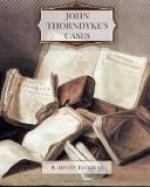“Schoenberg—Schoenberg? Ah, yes! I know. He lives on the third-floor. I saw him go up a short time ago. Third-floor back;” and indicating the open door with a wave of the hand, he raised his hat and passed into the street.
“I suppose we had better go up,” said the inspector, with a dubious glance at the row of bell-pulls. He accordingly started up the stairs, and we all followed in his wake.
There were two doors at the back on the third-floor, but as the one was open, displaying an unoccupied bedroom, the inspector rapped smartly on the other. It flew open almost immediately, and a fierce-looking little man confronted us with a hostile stare.
“Well?” said he.
“Mr. Adolf Schoenberg?” inquired the inspector.
“Well? What about him?” snapped our new acquaintance.
“I wished to have a few words with him,” said Badger.
“Then what the deuce do you come banging at my door for?” demanded the other.
“Why, doesn’t he live here?”
“No. First-floor front,” replied our friend, preparing to close the door.
“Pardon me,” said Thorndyke, “but what is Mr. Schoenberg like? I mean—”
“Like?” interrupted the resident. “He’s like a blooming Sheeny, with a carroty beard and gold gig-lamps!” and, having presented this impressionist sketch, he brought the interview to a definite close by slamming the door and turning the key.
With a wrathful exclamation, the inspector turned towards the stairs, down which the sergeant was already clattering in hot haste, and made his way back to the ground-floor, followed, as before, by Thorndyke and me. On the doorstep we found the sergeant breathlessly interrogating a smartly-dressed youth, whom I had seen alight from a hansom as we entered the house, and who now stood with a notebook tucked under his arm, sharpening a pencil with deliberate care.
“Mr. James saw him come out, sir,” said the sergeant. “He turned up towards the Square.”
“Did he seem to hurry?” asked the inspector.
“Rather,” replied the reporter. “As soon as you were inside, he went off like a lamplighter. You won’t catch him now.”
“We don’t want to catch him,” the detective rejoined gruffly; then, backing out of earshot of the eager pressman, he said in a lower tone: “That was Mr. Schoenberg, beyond a doubt, and it is clear that he has some reason for making himself scarce; so I shall consider myself justified in opening that note.”
He suited the action to the word, and, having cut the envelope open with official neatness, drew out the enclosure.
“My hat!” he exclaimed, as his eye fell upon the contents. “What in creation is this? It isn’t shorthand, but what the deuce is it?”
He handed the document to Thorndyke, who, having held it up to the light and felt the paper critically, proceeded to examine it with keen interest. It consisted of a single half-sheet of thin notepaper, both sides of which were covered with strange, crabbed characters, written with a brownish-black ink in continuous lines, without any spaces to indicate the divisions into words; and, but for the modern material which bore the writing, it might have been a portion of some ancient manuscript or forgotten codex.




